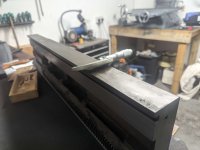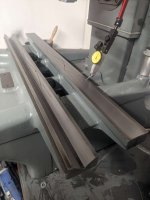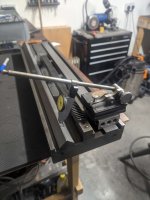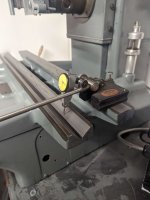Hello
I acquired an old, circa 1959, EXE toolroom surface grinder and am currently in the process of evaluating wear and developing a plan of action to rebuild the machine.
A bit of background. The machine is my first grinder. It was purchased at auction for a nominal sum without being seen. The plan was to expect lots of wear, and rebuild it as a project. I have a novice scraper, having done lathe saddles and the like, but this will be my biggest project.
Full information on the grinder can be found here: http://www.lathes.co.uk/exe-grinder/
When it arrived, it was absolutely filthy. I stripped it down, cleaned everything, and identified that the free screw (z axis) was shot, along with the nut, and the pinion gear for the rack was worn to shreds. Fortunately I was able to source used replacements of much better condition. The motor was originally 410v, so I had this professionally rewound and I had the armature rebalanced. It was reassembled and run using a VFD. The spindle sounds OK, but more on this later.
What I noticed was that the table top, when being fed forward and back (in z axis) showed that the rear of the table was high by .4mm when compared to the front. This was the same across the table. When the table was traversed on the X axis, there was limited variation in the readings. At that point, I thought someone either screwed up grinding the table top, or else the ways were worn (thereby dropping the front, operator side of of the table down). I then slapped the mag chuck on and repeated the rest indicating off the mag chuck, and whilst it needed grinding in, there was nothing near to a .4mm rise from front to the back. Obviously the previous owner solved the 'issue' by grinding the chuck: however this would not work for me as I plan on using the table surface for grinding.
I then took the table off and miked the width of the table at it's four corners. The front of the table was slightly narrower than the rear, but only .1mm so this doesn't account for everything.
After this, I indicated off the column onto the saddle flat (on the edges, where it is clearly unworn), and traversing the saddle so that I could then indicate off the tops of the (female) vee, again a virgin surface. This showed no deviation in the readings. What this suggests to me is two fold. First, the saddle is relatively square (along it's travel in z direction) to the column. Second, any cause for the slope on the table top would be down to a combination of the table top being slightly thicker at the rear, and that the remainder of the slope must, I THINK, be down to wear in the vee and flat surfaces of the underside of the table and the top side of the saddle. Perhaps the vee at the front is worn much more than the flat at the rear?
I also used a 1-2-3 block on the flat, resting along the edge (a machined 'lip' on the table) so that I could indicate off the vee. Interestingly, this showed that the indicator rise in one direction on one side of the vee, but decrease when indicating off the other side in the opposite direction. I hope that makes sense. I think this suggests that the vee is twisted.
The is the first issue I would like to address by scraping. Getting the saddle top and table scraped in, and hopefully in doing so bringing the top of the table closer to 'level'.
The second issue concerns the spindle. I cannot detect any major axial or radial play when turning the spindle. However, when I really reef on the spindle housing, there is about .04mm of axial play. I believe this actually is caused by poor mating between the spindle housing and the column. It is gibbed. As such, I want to explore the cause of this play further and address that by scraping where necessary.
I am going to post photos shortly, but need to figure out how to reduce their size.
In the meantime, photos can be found here: https://photos.app.goo.gl/JWLEAiX8WFc9pFju6
Any thoughts about what I've posted above, procedure, further checks I can carry out to investigate / be a detective, and then develope a game plan would be much appreciated.
Cheers!
I acquired an old, circa 1959, EXE toolroom surface grinder and am currently in the process of evaluating wear and developing a plan of action to rebuild the machine.
A bit of background. The machine is my first grinder. It was purchased at auction for a nominal sum without being seen. The plan was to expect lots of wear, and rebuild it as a project. I have a novice scraper, having done lathe saddles and the like, but this will be my biggest project.
Full information on the grinder can be found here: http://www.lathes.co.uk/exe-grinder/
When it arrived, it was absolutely filthy. I stripped it down, cleaned everything, and identified that the free screw (z axis) was shot, along with the nut, and the pinion gear for the rack was worn to shreds. Fortunately I was able to source used replacements of much better condition. The motor was originally 410v, so I had this professionally rewound and I had the armature rebalanced. It was reassembled and run using a VFD. The spindle sounds OK, but more on this later.
What I noticed was that the table top, when being fed forward and back (in z axis) showed that the rear of the table was high by .4mm when compared to the front. This was the same across the table. When the table was traversed on the X axis, there was limited variation in the readings. At that point, I thought someone either screwed up grinding the table top, or else the ways were worn (thereby dropping the front, operator side of of the table down). I then slapped the mag chuck on and repeated the rest indicating off the mag chuck, and whilst it needed grinding in, there was nothing near to a .4mm rise from front to the back. Obviously the previous owner solved the 'issue' by grinding the chuck: however this would not work for me as I plan on using the table surface for grinding.
I then took the table off and miked the width of the table at it's four corners. The front of the table was slightly narrower than the rear, but only .1mm so this doesn't account for everything.
After this, I indicated off the column onto the saddle flat (on the edges, where it is clearly unworn), and traversing the saddle so that I could then indicate off the tops of the (female) vee, again a virgin surface. This showed no deviation in the readings. What this suggests to me is two fold. First, the saddle is relatively square (along it's travel in z direction) to the column. Second, any cause for the slope on the table top would be down to a combination of the table top being slightly thicker at the rear, and that the remainder of the slope must, I THINK, be down to wear in the vee and flat surfaces of the underside of the table and the top side of the saddle. Perhaps the vee at the front is worn much more than the flat at the rear?
I also used a 1-2-3 block on the flat, resting along the edge (a machined 'lip' on the table) so that I could indicate off the vee. Interestingly, this showed that the indicator rise in one direction on one side of the vee, but decrease when indicating off the other side in the opposite direction. I hope that makes sense. I think this suggests that the vee is twisted.
The is the first issue I would like to address by scraping. Getting the saddle top and table scraped in, and hopefully in doing so bringing the top of the table closer to 'level'.
The second issue concerns the spindle. I cannot detect any major axial or radial play when turning the spindle. However, when I really reef on the spindle housing, there is about .04mm of axial play. I believe this actually is caused by poor mating between the spindle housing and the column. It is gibbed. As such, I want to explore the cause of this play further and address that by scraping where necessary.
I am going to post photos shortly, but need to figure out how to reduce their size.
In the meantime, photos can be found here: https://photos.app.goo.gl/JWLEAiX8WFc9pFju6
Any thoughts about what I've posted above, procedure, further checks I can carry out to investigate / be a detective, and then develope a game plan would be much appreciated.
Cheers!
Last edited:









